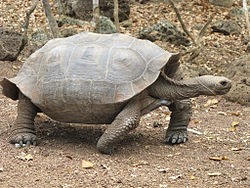The wildlife is the prime reason for visiting the Galapagos Islands in Ecuador. The logistics of travelling to and around the islands as well as information on the islands is given in the Galapagos Islands article itself.
Understand
[edit]Lying 1000km west of Ecuador on the South American mainland, the volcanic Galapagos Islands' wildlife developed and remained relatively protected until the 1800s. Charles Darwin visited the islands in 1835 and his studies here helped form his Theory of Evolution. Since then, although the influence of mankind has increased, the islands isolation has kept them remarkably unspoilt with some of the tamest wildlife you will ever encounter.
The National Park
[edit]The land of the islands was declared a national park in 1959, and the surrounding seas a marine biosphere in 1986.
What to bring / hire
[edit]- Binoculars
- Snorkeling equipment
- Camera
- Seasickness pills
Reptiles
[edit]Tortoises
[edit]Shell shape
[edit]The giant tortoises (Geocheleone elephantopus) are justly the most famous residents of the islands, weighing up to 200kg and living for up to 150 years. Each island with tortoises tends to have its own sub-species (but with five on Isabela) which have evolved separately. Though several of the islands have tortoises in the wild, for their own protection the national park does not allow visitors in many of these areas. The best places to see Tortoises while in Galapagos are while visiting Galapaguera de Cerro Colorado on the island of San Cristobal, either the Tortoise Breeding Center or the Wall of Tears area on Isabela where 5 year old and 25 year old tortoises have been re-released into the wild. Or either in the highlands of Santa Cruz or at the famous Charles Darwin Research Station in Puerto_Ayora where visitors can view tortoises from hatchlings to more distinguished individuals like Lonesome George (from Pinta) thought to be the last of his species.
Marine iguanas
[edit]The Marine Iguana' (Amblyrhyynchus cristatus) endemic to the Galapagos Islands can be seen sunning themselves (often on top of each other) on rocks at the sea edge of most of the islands. The world's only seagoing lizard, it feeds on seaweed. The iguanas are typically black but turn red during mating season - with the exception of on Espanola where they also appear green in color.
Land Iguanas
[edit]The Galapagos Land Iguana (Conolophus subscristatus) are another dinosaur like reptile which lives on most of the main islands. A grey-yellow colour, the move slowly - be careful not to walk on them. They eat the pads of the prickly pear cactus
The Santa Fe Land Iguana (Conolophus pallidus) lives only on Santa Fe and is slightly larger and chocolate brown in color.
Lizards
[edit]The Lava Lizard (Tropidurus) scurries around the rocky ground of the islands. There are seven species, which similarly to the Giant Tortoises are endemic to different islands.
Snakes
[edit]Geckos
[edit]Sea Turtles
[edit]Land Mammals
[edit]All animals that originally arrived in the islands came here either by swimming, flying or floating. Due to the long distance from the continent mammals were unable to make the journey making the giant tortoise the primary grazing animal in the Galapagos. Since the arrival of man to the Galapagos, many mammals have been introduced including goats, horses, cows, rats, cats and dogs. In many cases the introduction of these new species caused problems and has endangered the fragile eco-system and the plants and animals that live here.
Birds
[edit]Albatrosses
[edit]The Waved Albatross is considered endemic to the Galapagos Islands, these large birds with up to a 6 foot wingspan Albatross spend much of their life at sea, however from April to November they return to nest on the island of Espanola.
Boobies
[edit]There are three species of boobies found in the Galapagos the Black and White Nazca Booby, the Red Footed Booby and the popular Blue Footed Booby.
Nazca / masked boobies
[edit]Red-footed boobies
[edit]Can be found nesting in bushes on the island of Genovesa or on the easternmost tip of the islands at Punta Pitt on San Cristobal
Blue-footed boobies
[edit]The blue-footed booby (Sula nebouxii) is a bird in the Sulidae family which comprises ten species of long-winged seabirds.
The average life-span of the carnivorous bird is 17 years. Known for their blue feet, their dances and also their unruffled attitude toward humans, the blue-footed booby is one of the most popular wildlife attractions on the Galapagos Islands.
Flightless cormorants
[edit]An endemic species of the Galapagos Islands the flightless cormorant can be found on the western side of Isabela and Fernandina
Darwin finches
[edit]There are 15 species of Darwin finch, 14 of which are found in the Galapagos Islands. These small noisy birds can be found throughout the islands. One of these species the mangrove finch, found only on the western coast of Isabela is extremely endangered there is thought to be less than 100 of the species left.
Egrets & Herons
[edit]Flamingos
[edit]Frigatebirds
[edit]Galapagos Hawks
[edit]Mockingbirds
[edit]Oystercatchers
[edit]Brown Pelicans
[edit]Pelecanus occidentalis, with its sympathetic appearance and elegant flight abilities, is an ubiquitous presence on the islands, especially at harbors and fish markets.
Galapagos Penguins
[edit]The small endemic Galapagos Penguins (Spheniscus mendiculus) are the northernmost penguins in the world. Penguins can typically be seen on Fernandina, Floreana, Isabela, Bartolome and Sombrero Chino.
Plovers
[edit]Storm Petrels
[edit]Tropicbirds
[edit]Yellow Warblers
[edit]Sea Mammals
[edit]Sea Lions
[edit]Fur Sea Lions
[edit]Whales
[edit]Dolphins
[edit]Fish
[edit]Sharks
[edit]Rays
[edit]Anglefish
[edit]Invertebrates
[edit]Sally Lightfoot Crabs
[edit]Born black to blend in with their environment the Sally Lightfoot crab turns red, orange and yellow with age. A favorite of photographers these crabs can be found throughout the islands near the shoreline.
Sea Urchins
[edit]Sea Cucumbers
[edit]Sea Anenomies
[edit]Star Fish
[edit]Plants
[edit]Cacti
[edit]Mangroves
[edit]Scalesia
[edit]Known as the Darwin Finch of the plant family, the Scalesia is a member of the daisy family. The Scalescia forests on Santa Cruz are home to both wild tortoises and a variety of birds like the colorful vermilion fly catcher, Darwin Finch and yellow warblers.



